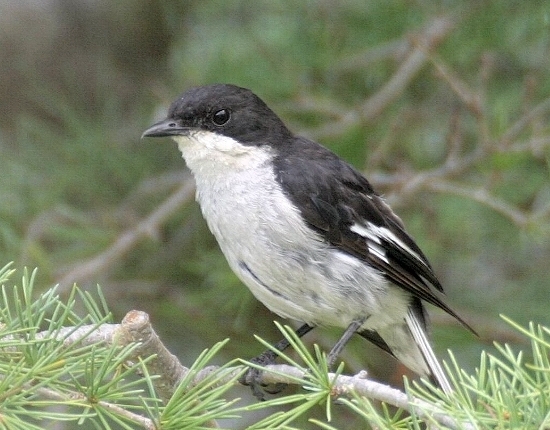m |
|||
| Line 1: | Line 1: | ||
| − | |||
;Sigelus silens | ;Sigelus silens | ||
[[Image:Fiscal_Flycatcher.jpg|thumb|550px|right|Photo taken at Kleinmond, near Cape Town, South Africa, by Max Holdt]] | [[Image:Fiscal_Flycatcher.jpg|thumb|550px|right|Photo taken at Kleinmond, near Cape Town, South Africa, by Max Holdt]] | ||
| Line 7: | Line 6: | ||
==Identification== | ==Identification== | ||
| − | This black and white bird gets its name from its resemblance to the Common Fiscal, a shrike. The Fiscal Flycatcher is 17-20 cm in length, 26 g. The adult male is black above and white below with white wing patches and white sides to the tail. The female is brown, not black, above. The juvenile is like the female but duller and with brown spots and scalloping above and below. The male can be confused with the Common Fiscal, but the shrike has a heavy hooked bill, a white patch on the shoulder rather than the lower wing, and has no white its longer tail. The Fiscal Flycatcher is larger than the male Collared Flycatcher, which has a white collar and lacks white wing panels. | + | This black and white bird gets its name from its resemblance to the [[Common Fiscal]], a shrike. The Fiscal Flycatcher is 17-20 cm in length, 26 g. The adult male is black above and white below with white wing patches and white sides to the tail. The female is dark brown, not black, above. The juvenile is like the female but duller and with brown spots and scalloping above and below. |
| + | |||
| + | The male can be confused with the [[Common Fiscal]], but the shrike has a heavy, hooked bill, a white patch on the shoulder rather than the lower wing, and has no white on its longer tail. The Fiscal Flycatcher is larger than the male [[Collared Flycatcher]], which has a white collar and lacks white wing panels. | ||
==Distribution== | ==Distribution== | ||
| + | Southern Africa. | ||
==Taxonomy== | ==Taxonomy== | ||
==Habitat== | ==Habitat== | ||
| − | Most common in moist and semi-arid lowland grasslands, valley bushveld and fynbos. | + | Most common in moist and semi-arid lowland grasslands, valley bushveld and fynbos. The species favours fairly open vegetation, with some trees or shrubs as perches. |
| + | ==Behaviour== | ||
| + | The Fiscal Flycatcher feeds on insects, often taken in flight and occasionally joins mixed-species foraging flocks. Most foraging is conducted from a perch, often on the top of a bush or small tree, or on a fence, powerline or telephone line. | ||
| − | + | The Fiscal Flycatcher builds an open cup nest from thin stems and other plant material and lined with plant down. It is placed in a dense bush or tree up to 6 m above the ground. | |
| − | |||
| − | The Fiscal Flycatcher builds an open cup nest from thin stems and other plant material and lined with plant down. It is placed in a dense bush. | ||
The song is a weak chittering, and the alarm call is ''tssisk''. | The song is a weak chittering, and the alarm call is ''tssisk''. | ||
Revision as of 12:23, 12 November 2007
- Sigelus silens
Other Names
German: Würgerschnäpper; Afrikaans: Fiskaalvlieëvanger
Identification
This black and white bird gets its name from its resemblance to the Common Fiscal, a shrike. The Fiscal Flycatcher is 17-20 cm in length, 26 g. The adult male is black above and white below with white wing patches and white sides to the tail. The female is dark brown, not black, above. The juvenile is like the female but duller and with brown spots and scalloping above and below.
The male can be confused with the Common Fiscal, but the shrike has a heavy, hooked bill, a white patch on the shoulder rather than the lower wing, and has no white on its longer tail. The Fiscal Flycatcher is larger than the male Collared Flycatcher, which has a white collar and lacks white wing panels.
Distribution
Southern Africa.
Taxonomy
Habitat
Most common in moist and semi-arid lowland grasslands, valley bushveld and fynbos. The species favours fairly open vegetation, with some trees or shrubs as perches.
Behaviour
The Fiscal Flycatcher feeds on insects, often taken in flight and occasionally joins mixed-species foraging flocks. Most foraging is conducted from a perch, often on the top of a bush or small tree, or on a fence, powerline or telephone line.
The Fiscal Flycatcher builds an open cup nest from thin stems and other plant material and lined with plant down. It is placed in a dense bush or tree up to 6 m above the ground.
The song is a weak chittering, and the alarm call is tssisk.




